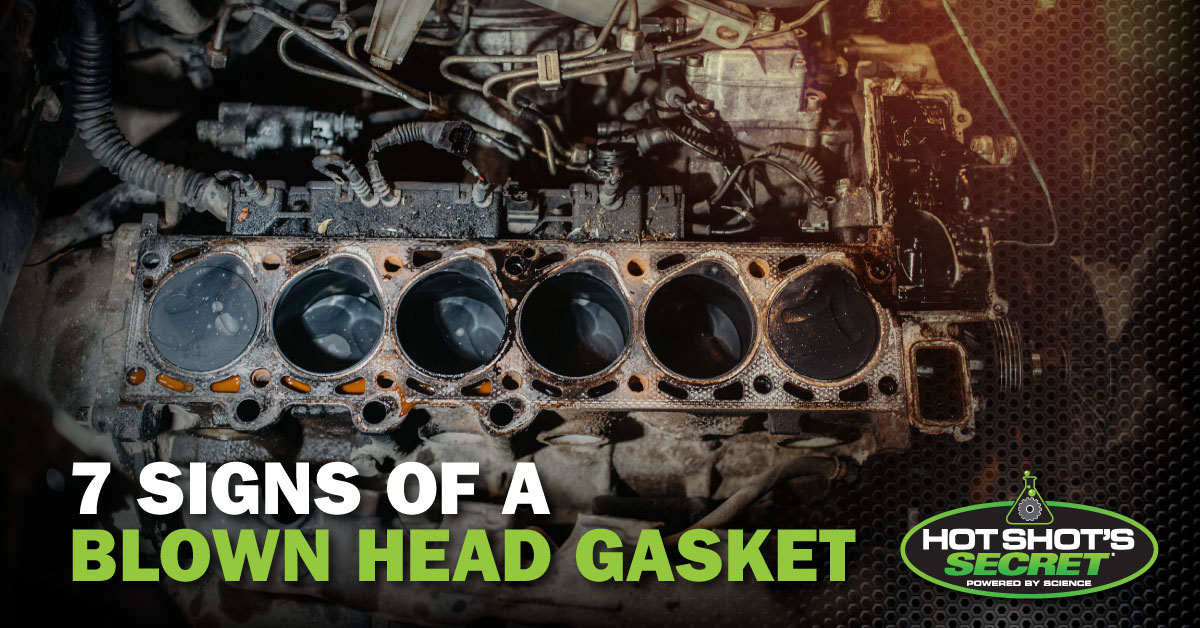
When your vehicle’s head gasket fails, it affects engine performance and can lead to severe and costly damage. Knowing the first signs of a blown head gasket early on can save you from expensive repairs and lengthy downtime.
Catch the First Symptoms of a Blown or Leaking Head Gasket
You may be able to tell that a head gasket is blown if you notice any of these issues:
1. Engine Overheating
A sudden rise in engine temperature may indicate a head gasket problem. Overheating typically results from coolant loss, which may occur without visible leaks. It happens as coolant seeps into the cylinders and burns away as steam or as hot combustion gases escape into the cooling system.
2. White Smoke From the Exhaust
A telltale sign of a cylinder gasket leak is sweet-smelling, white smoke from the exhaust when coolant leaks into the combustion chamber, where it vaporizes and exits through the exhaust system. Look for consistent white smoke, especially after starting the engine or during acceleration, as it indicates coolant intrusion.
3. Loss of Coolant With No Visible Leaks
When coolant levels drop without apparent leaks, it often means the coolant is seeping into the combustion chamber or mixing with the engine oil, reducing its volume in the radiator and expansion tank. If not addressed, this hidden loss can lead to severe engine damage.
4. Milky Oil From Oil Contamination
A milky or frothy appearance in your engine oil often signals coolant contamination. This issue occurs when a failed head gasket allows coolant to mix with engine oil, creating what’s sometimes called “engine mayonnaise.” Check the dipstick and oil filler cap for this telltale sign. Ignoring this issue can lead to engine failure, as contaminated oil cannot provide adequate lubrication, leading to accelerated wear on bearings and moving parts.
5. Bubbling in the Radiator or Coolant Reservoir
Combustion gases entering the cooling system may cause visible bubbles in the radiator or overflow tank. Bubbles form as high-pressure gases push past the failed gasket into areas designed solely for coolant. Observing bubbles with the cap off when the engine is cold reveals whether combustion pressure is affecting the cooling system.
6. Loss of Engine Power and Misfires
A damaged head gasket can allow compressed air and fuel to escape, resulting in a loss of compression in one or more cylinders. Insufficient compression leads to noticeable power loss, rough idling and hesitation during acceleration. You might also hear a faint hissing noise, similar to an exhaust leak. Left unchecked, these symptoms can strain other engine components.
7. Check Engine Light (CEL) and Diagnostic Trouble Codes (DTCs)
A failing head gasket often triggers the check engine light. Misfires or abnormal coolant temperature readings generate diagnostic trouble codes like P0300 (random misfire) or P0118 (engine coolant temperature (ECT) circuit issues). Use an OBD-II scanner to confirm the codes and investigate further.
Preventing a Blown Head Gasket in the Future
Preventing a blown head gasket is essential to avoid costly repairs and engine damage. Here are some key maintenance tips to keep your engine running smoothly and reduce the risk of seeing head gasket failure symptoms in the future:
Regular Maintenance
Taking proactive steps can significantly reduce the risk of head gasket failure:
- Coolant checks: Regularly check the coolant levels and condition. Low coolant can lead to overheating, a common cause of cracks and leaks. Make sure your vehicle’s radiator is in good working condition.
- Oil changes: Clean engine oil ensures proper lubrication and heat dissipation. Regular oil changes also prevent sludge buildup that can compromise the gasket.
- Cooling system inspection: Frequently inspect the radiator, water pump and thermostat for signs of wear or blockage. Ensuring these components function correctly helps maintain the engine’s temperature and prevents excessive heat buildup.
Avoid Overheating
Some practical ways of preventing engine overheating include:
- Monitoring engine temperature: Always check the engine’s temperature gauge. If it starts to overheat, turn it off immediately to avoid further deterioration.
- Proper coolant management: Always top off your coolant with the right mixture of coolant and water. Ensure there are no air pockets in the system that could reduce the effectiveness of the cooling process.
Use Quality Coolant and Oil
Quality coolant and oil are essential for optimal engine performance:
- Choose the proper fluids: Using the correct grade of coolant and engine oil for your vehicle ensures that your engine operates at the correct temperature and under optimal conditions.
- Check for contaminants: Contaminated coolant or oil can lead to poor lubrication and inefficient heat dissipation, increasing the likelihood of head gasket failure.
Monitor Engine Performance
Being aware of subtle changes in engine performance can help avoid severe failures:
- Watch for signs of engine trouble: Pay attention to unusual sounds like knocking, rough idling or hesitation when accelerating. These could be early indicators of engine trouble, including cracked head gasket symptoms.
- Address issues immediately: If your vehicle shows signs of misfires, overheating, loss of power or other performance issues, address them promptly to prevent further destruction to the head gasket.
How Hot Shot’s Secret Products Can Help Prevent Head Gasket Failure
Hot Shot’s Secret provides innovative solutions to maintain engine health and prevent issues like head gasket failure. These include:
- Stiction Eliminator: Stiction Eliminator works by removing sludge, varnish, and carbon desposits from critical engine parts, such as oil passages and piston rings. By cleaning these areas, it ensures smooth operation and reduces the likelihood of hot spots and uneven thermal expansion, which are common contributors to head gasket stress. Additionally, it reduces friction and heat within the engine, helping to prevent overheating—a major cause of gasket failure. The product also improves oil flow and restores the oil’s ability to lubricate effectively, maintaining even pressure and minimizing strain on the head gasket.
- FR3 Friction Reducer: FR3 Friction Reducer complements these benefits by reducing internal friction through its advanced nano carbon lubricant formula. This reduction in friction results in lower heat generation, helping to stabilize engine temperatures and mitigate thermal stress on the head gasket. FR3 also enhances the oil’s performance by boosting its film strength, ensuring better lubrication and minimizing wear on engine components. Its ability to improve heat dissipation further prevents localized overheating, which can warp the cylinder head or block and lead to gasket failure. By prolonging the life of moving parts, FR3 indirectly protects the head gasket by preserving the structural integrity of the engine.
Maintain Engine Integrity With Hot Shot’s Secret
Recognizing the signs of a blown head gasket and implementing preventive measures can safeguard your vehicle’s performance and longevity. Hot Shot’s Secret provides the advanced solutions needed to maintain your engine’s fuel and oil systems, ensuring optimal performance and reducing the risk of head gasket failure. Explore our premium products today and take proactive steps toward a healthier, more efficient engine.
